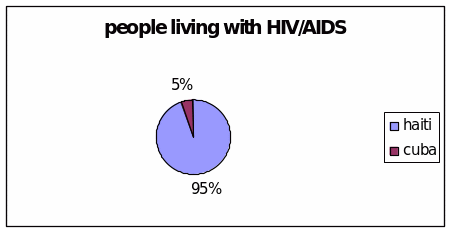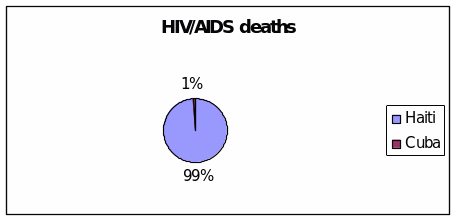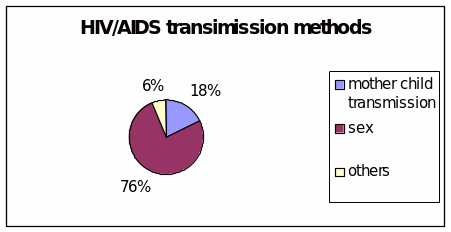Profile of HIV/AIDS in Haiti in comparison to other states
The first case of HIV/AIDS in the Republic of Haiti was identified in the year 1982 and the country has continuously grappled with the epidemic for over twenty-five years (Celentano & Beyrer 2008). The epidemic first started in the urban epicenter, Port au Prince and later traveled to the rural areas. Today, the republic of Haiti is the home to the largest HIV/AIDS epidemic in Latin America and the Caribbean. Estimates drawn from sentinel surveillance data suggested that some 190,000adults and children were living with HIV in the year 2005 accounting for 76 percent of all HIV cases in Caribbean region (Cantwell 1986). In 2005 there were 16,000 HIV-related deaths in Haiti which comprised 84 percent of all HIV-related deaths reported in Caribbean countries (Cantwell 1986).
Cuba has the lowest HIV/AIDS prevalence in the Caribbean region and the whole world. Cuba is one of the 51 countries with HIV/AIDS infection rate below 0.2 percent. None of the Caribbean countries and territories has been spared from HIV/AIDS. Some Caribbean countries have the highest prevalence of HIV/AIDS among adults in Latin America and Caribbean (Farmer 2006). Haiti with HIV prevalence of 5.17% is the most affected country in the world outside of sub Saharan Africa. Cuba on the other hand has one of the lowest rates in the Americans with 0.02% (Celentano & Beyrer 2008). In terms of numbers of HIV/AIDS cases in the Caribbean, two countries stand out (Cantwell 1986). These two countries are Haiti and the Dominican Republic which account for 85 percent of the total number of HIV/AIDS cases in Caribbean (Farmer 2006).
HIV/AIDS epidemic is spreading alarmingly in the Caribbean region. Countries like Haiti, Bahamas, Barbados, the Dominican Republic and Guyana have generalized epidemics. This means that HIV has spread far beyond the original subpopulations with high risk behavior and 5 percent of women attending prenatal clinics are infected (Ainsworth & Vaillacourt 2005).
On the other hand Jamaica and Trinidad and Tobago have concentrated HIV/AIDS epidemics. This means that their national epidemics are still affecting primarily population groups practicing high risk behaviors but are set to spread more widely in the to the rest of the population (Dayton 1998).
The Haitian Aids epidemic is generalized because it affects women as much as men. An HIV case in Haiti is not limited to a specific social group or geographical locations. The most affected groups however are the urban poor, who are also found to be suffering a lot from other opportunity diseases like TB (Ainsworth & Vaillacourt 2005). A survey conducted in an urban slum in Port au Prince showed that 15 percent of all adults were infected with HIV. The rate of active and thus infectious tuberculosis among these HIV-positive slum dwellers was 5,770 per 100,000 populations. In 2007 the estimated number of adults (15-49) with HIV/AIDS was 2.5 million while that of infected children was 8,100, and children death in 2007 was 7,200 (Ainsworth & Vaillacourt 2005).
In 2005, about 360,000 persons were reported to be living with HIV/AIDS in the Caribbean region. The Caribbean region has the highest prevalence of HIV in any region of the world other than the AIDS ravaged sub-Saharan Africa, where the prevalence of HIV among adults aged 15 to 49 is reported to be 8.0 percent (Celentano & Beyrer 2008). The primary mode of HIV transmission among adults in the Caribbean region is sexual intercourse between men and women. For that reason the percentage of women with HIV/AIDS is rising and as of 2005 about 35 percent of the adults affected with HIV in the Caribbean region were women. Children under age fourteen currently account for only a small part of the known infected population in the Caribbean region as a whole. Most young children are infected by their infected mothers during pregnancy, delivery or breastfeeding.



Economic and health situations in Haiti
The health situation in Haiti is in crisis, especially for young children. The country has poor sanitation, limited access to safe drinking water, waste management problems, poor nutrition and severe in adequate medical facilities (Ainsworth & Vaillacourt 2005). Contributing factors are the high rising air pollution problem in Port au Prince, considerable poverty environmental degradation and susceptibility of natural disaster and failure of state spending for healthy care (Ainsworth & Vaillacourt 2005). AIDS is the leading cause of adult deaths in Haiti of 22 percent. Thus it has greatly affected children and adolescent mortality rates. On annual basis, 5,000 children are born with the virus (Cantwell 1992).
Access to safe drinking water is a major problem with potable water reaching less than 50 percent of the population both in rural and urban areas. Only about one in two children get all the needed immunization, putting them at risk of contracting opportunistic diseases (Ainsworth & Vaillacourt 2005). A significant number of children (18%) under five years of age suffer from severe malnutrition. There are thousands of orphaned and abused children many of them living in the streets in perilous states. Teenage pregnancy is common with girls aged fifteen to nineteen as is the incidence of sexually transmitted diseases in both teenage girls and boys. Approximately seven percent of the population has some sort of disability, half these being the children. There are only 2.5 doctors per 10,000 Haitians and about 75 percent of all births occur without medical attention (Ainsworth & Vaillacourt 2005).
Diarrhea is considered one of the leading causes of death among the young children, “with other primary causes of death being intestinal infections, malnutrition and respiratory infections” (Celentano & Beyrer 2008). Among children aged five to nine, the leading cause of death is infectious and parasitic diseases and about 20 percent are considered to be living in a state of vulnerability. The leading cause of death among adolescence from ages ten to nineteen is HIV/AIDS (Celentano & Beyrer 2008).
Since Haiti has the second lowest per capita caloric intake in the world, malnutrition is wide spread especially among the young and the poor. Haiti’s GDP per capita is US$24 just above the sub Saharan African coverage, and its social indicators are significantly lower than those of the poorest countries in the Western Hemisphere and are comparable to those of Sub Saharan Africa (Britain 2008).
Population pressure has exacerbated poverty in Haiti. The high fertility rate exerts pressure on the environment and reduces available resources per capita for basic education, health, sanitation and access to safe drinking water. The urbanization ratio in Haiti is below the average level for western hemisphere. 65 percent of Haitians live below the poverty line. The high fertility rate has particularly adverse impact on children. Some children of low income earners, especially girls under the age of 14 are employed as domestic helpers under dismal conditions while some resort to prostitution and drug business, further putting them at more risk
Substantial disparities and limited opportunities in rural areas have caused migration to urban areas. This has resulted into rapid proliferation of slums in Haitian cities. Haiti’s population density of 278 persons per square km is by far the highest among the comparator countries. The death rate in Haiti is 13 per 1,000 people a year and is about twice that of Guyana, Honduras or Nicaragua. Life expectancy is only 52 years, the lowest among countries in the Western Hemisphere, a phenomenon attributed to poor access to health care services, malnutrition and insecurity created by the economic and political distress (Farmer, Saussy & Kidder 2010).
The degree to which food needs are met in Haiti is very low. More than half of the population is unable to obtain the minimum food ration established by FAO. A WFT report on food security and vulnerability showed that household that faces food insecurity do not have adequate income and have a low level of access to such basic essential services like drinking water and health services. This is mostly common in rural areas and shantytowns where only 25 percent of inhabitants have access to drinking water and very few persons have access to adequate health facilities. Overall, households have a low access to health care and markets and also low levels of education and schooling. Access to basic social services remains very limited where more than 77 percent in the 133 municipalities in Haiti lack basic services.
The degree to which house holds meet their basic needs is very limited particularly in rural areas. In rural areas only 13.1 percent of household think that they can meet their basic foods needs and 9 percent think that they can address their health problems compared to 33 percent and 28 percent in metropolitan area. Four of every five households indicated that they are unable to properly meet their food needs. They also indicated that a reduction in their food ration is their first line of action in such situations. Approximately 32 percent of the household indicated that they would use potential additional income to improve their food situation (Griffith 2004).
More than 70 percent of heads of household believe that poverty has increased particularly in the recent years. Job creation, controlling inflation and access to land are the primary measures recommended by households to address poverty. They appear to view the problem largely in terms of purchasing power and access to the means of production. The incidence of poverty is clearly higher in rural areas than in the metropolitan areas. Extreme poverty is almost three times higher in rural areas than in the metropolitan area. The vast majority of the poor live in rural areas where agriculture is the main activity and where basic services are virtually non-existent.
Responses to HIV/AIDS and Funding
In December 2002, “Haiti became the first country in the Western Hemisphere to receive a grant from the global fund to fight AIDS, Tuberculosis and malaria” (Lieberman 2009). The $25million was to assist a consortium, led by the NGO GHESKIO and including the Haitian government to run low cost clinics for people living with HIV/AIDS and tuberculosis. The GHESKIO clinics are recognized as a model of how countries facing political upheaval, poverty and crumbling infrastructure can combat AIDS (Lieberman 2009). GHESKIO has developed methods of diagnosing sexually transmitted diseases and has found some less expensive drugs combinations to treat AIDS. This NGO together with other private groups use funds provided by foundations and foreign government to buy the medicines which are priced far beyond the reach of most Haitians. The grant is also meant to assist the NGO partners in health to provide health education and outreach to villages. Haiti’s health ministry also receives money to help it developing its planning ability and to coordinate the various projects.
National AIDS programmes (NAP) in the Caribbean were initially guided by the World Health Organization global programme on AIDS that later disbanded to form UNAIDS. NAPs have received technical support and guidance from agencies such as CARICOM, the Caribbean epidemiology centre (CAREC), Pan American Health Organization (PAHO) and UNAIDS. In 1998 the Caribbean Task Force on HIV/AIDS was formed with a mandate to coordinate and strengthen the regional response to the epidemic. The Task Force was chaired by the CARICOM secretariat and included experts in key HIV/ AIDS programming areas such as the Caribbean regional Network of people living with AIDS (Long & Ankrah 1996).
Task force was the formulation of the Regional Strategic Plan (RSP). This plan provided the frame work to inform and direct the expanded response to the problem of HIV in the region as well at the national and sector levels. The objective of the plan was therefore to provide support and guidance to national efforts to prevent and control the spread of HIV and mitigate its consequences. Regional finance ministers endorsed the plan at the June 2000 meeting of the Caribbean Group on Cooperation in Economic Development (CGCED) held at the World Bank. More was required to ensure sustained commitment at all levels. It was agreed that the task force be expanded to what is now the Pan Caribbean Partnership against HIV/AIDS (PANCAP), and “the partnership established on February 14, 2001 aimed at scaling up the regional response” (Miles 2004, p.58). It operates under “the aegis of the Caribbean Community (CARICOM) secretariat and is charged with providing support to the priority actions” (Miles 2004, p.58). It aims at being the regional coordinating committee for addressing the epidemic (Miles 2004).
Family health International is implementing the AIDS Care and Prevention Project in 25 countries including Dominican Republic and Jamaica. The AIDS communication project of the Academy of Educational Development (AED) also provides support for HIV/AIDS education and information in the early response to HIV/AIDS. It also provides residence advice assistance to some Caribbean countries. In the Dominican Republic, Haiti and Jamaica, USAID provides about US$6 million to support the STD/HIV/AIDS program. The money is also used to support NGOs and private sector groups. USAID has supported the Haitian Government’s response to HIV/AIDS through the Health System 2004 project, which focuses on condom social marketing, voluntary counseling and testing for HIV and strategic planning (Shenton 1998).
Programmes to change behavior encourage safe sex and distribute condoms national wide have been set up by most agencies involved in HIV in Haiti. The country has received significant support from the global fund and USAID to promote and sell condoms. Most health facilities in Haiti are now able to treat STIs. Vulnerability reduction activities focus primarily on factors that could lead youth and women to unsafe sex. These factors include economic factors, inadequate capacity for negotiation and emotional immaturity. A number of organizations have empowerment programmes for young women, income generation activities and peer to peer net work (Singhal & Rogers 2003).
The impact reduction component comprises activities in treatment, mitigation and stigma reduction. Four centers offer combination ART; these centers are GHESKIO, the Cange Hospital in the Central Plateau of Haiti, the MARCH foundation and the Salvation Army medical centre. These centers also offer comprehensive community based support services for HIV infected individuals. Many Haitian and international health organizations are working to prevent and slow the spread of HIV. They are also working to treat Haitians who are already infected with virus or sick with AIDS. Since AIDS can be spread through sexual activities, AIDS workers are educating the Haitian people about using condoms in order to prevent the spread of HIV during sex. HIV can also spread from a mother to a baby during the birth process (Street 2004). For this reason, the AIDS workers are treating some HIV-positive pregnant women with drugs that can prevent this transmission. Other workers distribute drugs that help people with AIDS live longer lives.
Conclusion
Haiti is the forth poorest in the world and for this reasons it has the highest number of people living with HIV/AIDS (Celentano & Beyrer 2008). Today, the republic of Haiti is the home to the largest HIV/AIDS epidemic in Latin America and the Caribbean (Celentano & Beyrer 2008). Estimates drawn from sentinel surveillance data suggested that some 190,000adults and children were living with HIV in the year 2005 accounting for 76 percent of all HIV cases in Caribbean region (Cantwell 1986). On the other hand, Cuba has the lowest HIV/AIDS cases with a prevalence rate below 1 percent. HIV AIDS in Haiti is of highest profile, far much higher that any other Caribbean nation. Although the neighboring countries also face similarly bigger HIV cases, the Haitians have born the brunt of this calamity and the problem seem to increasing in magnitude on a daily basis (Celentano & Beyrer 2008). The increased spread is associated with multiple factors ranging from economic to social factors (Celentano & Beyrer 2008). Several measures such as funding of AIDS prevention programs have been taken into consideration to curb the problem of HIV/AIDS. Many Haitian and international health organizations are working to prevent and slow the spread of HIV. They are also working to treat Haitians who are already infected with virus or sick with AIDS (Celentano & Beyrer 2008). This article has explained the cases of HIV/AIDS in Haiti. It has also given a comparison of HIV/AIDS prevalence in Haiti and other countries like Cuba. The article has also looked at the economic situation in Haiti and the country’s response towards HIV/AIDS cases in the country.
Reference List
Ainsworth, M., & Vaillacourt, D. (2005) Committing to results: improving the effectiveness of HIV/AIDS assistance. New York. World Bank Publications.
Britain, G. (2008) HIV/AIDS: Oral and written evidence. New York. The Stationery Office.
Cantwell, A. (1986) AIDS, the mystery and the solution. Chicago. Aries Rising Press.
Cantwell, A. (1992) AIDS And the Doctors of Death: An Inquiry Into the Origin of the AIDS Epidemic. Chicago. Aries Rising Press.
Celentano, D., & Beyrer, C. (2008) Public health aspects of HIV/AIDS in low and middle income countries: epidemiology, prevention and care. California. University of California Press.
Dayton, J. (1998) World Bank HIV/AIDS interventions: ex-ante and ex-post evaluation. New York. World Bank Publications.
Farmer, P. (2006) Aids and accusation: Haiti and the geography of blame. California. University of California Press.
Farmer, P., Saussy, H., & Kidder, T. (2010) Partner to the Poor. California. University of California Press.
Griffith, I. (2004) Caribbean security in the age of terror: challenge and change. Chicago. Ian Randle Publishers.
Lieberman, E. (2009) Boundaries of contagion: how ethnic politics have shaped government responses to AIDS. Chicago. Princeton University Press.
Long, L., & Ankrah, E. (1996) Women’s experiences with HIV/AIDS: an international perspective. Columbia. Columbia University Press.
Miles, M. (2004) Let Haiti live: unjust U.S. policies towards its oldest neighbor. Chicago. Educa Vision Inc.
Shenton, J. (1998) positively false: exposing the myths around HIV and AIDS. New York. Palgrave Macmillan.
Singhal, A., & Rogers, E. (2003) Combating AIDS: communication strategies in action. Chicago: SAGE.
Street, A. (2004) Haiti 2004: a nation in crisis. Chicago. CIIR.
